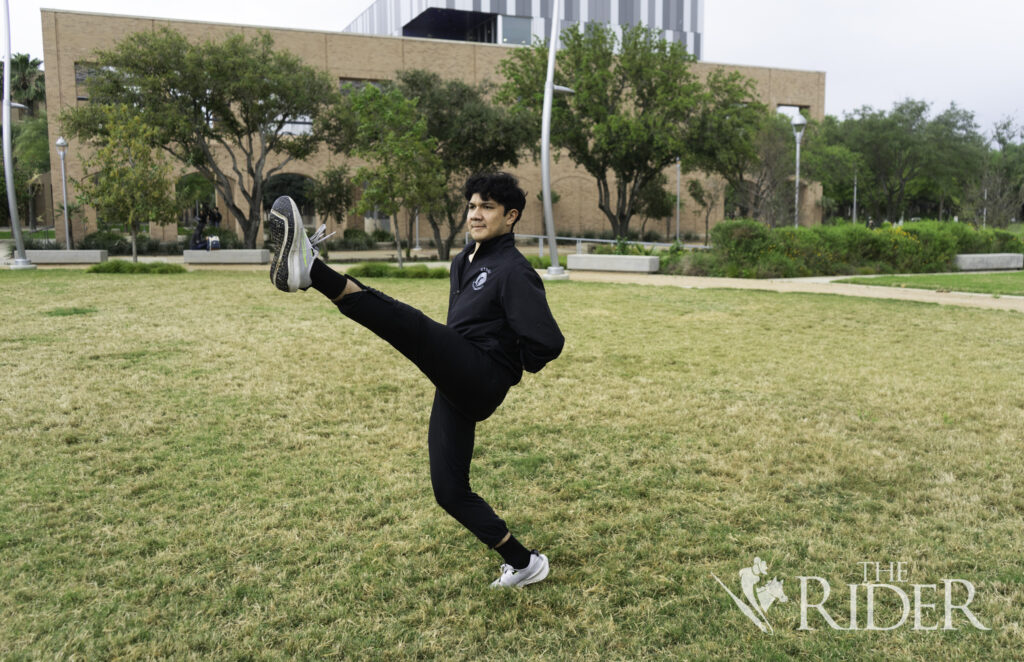The Ballet Folklórico at UTRGV has qualified for the 2025 American College Dance Association, National College Dance Festival after a strong showing at the regional level March 12 to 15 at Texas State University.
The dance company will travel May 2 to 4 to the John F. Kennedy Center for the Performing Arts in Washington, D.C. to compete against some of the best dance departments across the United States.
“It’s an honor getting to continue the legacy,” said Emmanuel Peralez, exercise science and dance senior and a Ballet Folklórico member.

PHOTO COURTESY MIGUEL PEÑA
This marks the fifth year the company has advanced to the ACDA National College Dance Festival.
Its qualifying performance featured a 12-minute version of “La Veracruz,” from their repertoire, showcasing elaborate costumes and live mariachi music.
“The rich rhythms that infuse this piece weave seamlessly with the entire design, from the music and the set pieces to the exquisite costumes and props, to craft a vibrant and layered visual and aural culture,” according to an ACDA National College Dance Festival announcement. “This work reminds us that we all come from somewhere, and offers a radical joy that affirms life, relationship and love.”
Miguel Peña, director of the UTRGV Ballet Folklórico, said the audience responded enthusiastically to the performance.
“You could feel the vibe of the people like just going crazy, yelling, applauding and [giving] standing ovations,” Peña said.
He said one adjudicator was so moved by the performance that “‘by the end of the piece, I was crying,’” they confessed during their critique.
In addition to the company’s selection, Peralez was chosen to perform a solo piece at the festival’s gala concert, the first time a faculty and student choreographer was selected for the gala in the same year.
Peralez described the selection as “kind of like a dream that you’ve always dreamed of.”

Eduardo Escamilla/THE RIDER
His piece “Hey, I’m Walkin’ Here!” is influenced by the Broadway sensation “Stomp,” which blends Mexican folklórico footwork with tap. Peralez added the adjudicators coined this hybrid as “folk tap.”
He said his interest in folklórico began in middle school.
Initially hesitant because he thought the art form was just for girls, he joined to get to know a girl in his class who was in folklórico. Despite that not working out, he stayed with the group and “fell in love with it.”
Peralez told The Rider about the strong bonds within the dance ensemble.
“It’s definitely … like a family, you know,” he said. “We have the same love for what we do [and] we have the same love for each other. … Of course, like any other family, we have our slight differences every now and then.”
Peña emphasized the dancers’ commitment and hard work.
“They work super, super hard all the time,” he said.
Peña detailed their demanding practice schedule, adding they often practice three hours a day, twice a week and, sometimes, work through breaks.
“[The practice time] is not unusual, but the thing that is unusual is that we have … no summer breaks,” he said. “Sometimes, we work through Spring Break and through the winter breaks as well.”
The director also emphasized the importance of sharing their art form and the impact it has on audiences unfamiliar with it.
Peña added he hoped the Folklórico members take away a feeling of accomplishment.
“That’s what I want them to take home, like, how people do appreciate and do recognize all our effort outside of [our] circle of comfort,” he said.
The company is looking forward to performing at the national level.
“It’s a different feeling when it’s … an audience full of dance people,” Peralez said. “… They know what they’re gonna be seeing. They know what it’s like to be on stage and have that energy get thrown on them. I know that the room is gonna be crazy and that’s just, like, the feeling that I’m looking forward to.”






